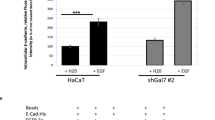Abstract.
Classical cadherins are Ca2+-dependent homotypic intercellular adhesion molecules that play major regulatory roles in tissue morphogenesis. Human epidermis, which expresses two classical cadherins (E- and P-cadherins), undergoes continual differentiation and morphogenesis, not just during embryonic development, but throughout life. The relative roles of E- and P-cadherin in epidermal morphogenesis have been studied in human epidermal keratinocytes in culture. In these cultures, tissue morphogenesis can be initiated simply by elevation of the extracellular Ca2+ concentration, which activates the cadherins, initiates desmosome organization, and then induces reorganization of the culture from a monolayer into a multilayered, more differentiated, epithelial-like structure. By examination of cultures after several days in high Ca2+, previous data have shown that concurrent inhibition of both E- and P-cadherins nearly abrogates the Ca2+-induced stratification response; however, it has not been possible to discern from these studies whether the two cadherins have unique or redundant regulatory properties. The present study has demonstrated, via electron-microscopic analysis of cultures at an early stage in stratification, that inhibition of either of the cadherins alone does not affect the initiation of stratification, i.e. the formation of up to 2–3 cell layers. Thus, E-cadherin and P-cadherin may have similar regulatory functions with respect to the initiation of stratification. However, if stratification is to continue further to produce a tissue-like structure of 5–7 cell layers, then E-cadherin is required and P-cadherin cannot act as a substitute, presumably because of the distinct localizations of E- and P-cadherins; E-cadherin is found in all cell layers of the stratified epithelium, whereas P-cadherin is lost after the basal keratinocytes become detached from the basement membrane and assume a suprabasal position. Therefore, basal cells, which have two cadherins, can utilize either cadherin to initiate stratification, whereas superficial cells, which have only E-cadherin, are dependent on this cadherin for further stratification.
Similar content being viewed by others
Author information
Authors and Affiliations
Additional information
Received: 19 March 1996 / Accepted: 22 August 1996
Rights and permissions
About this article
Cite this article
Jensen, P., Telegan, B., Lavker, R. et al. E-cadherin and P-cadherin have partially redundant roles in human epidermal stratification. Cell Tissue Res 288, 307–316 (1997). https://doi.org/10.1007/s004410050816
Issue Date:
DOI: https://doi.org/10.1007/s004410050816




